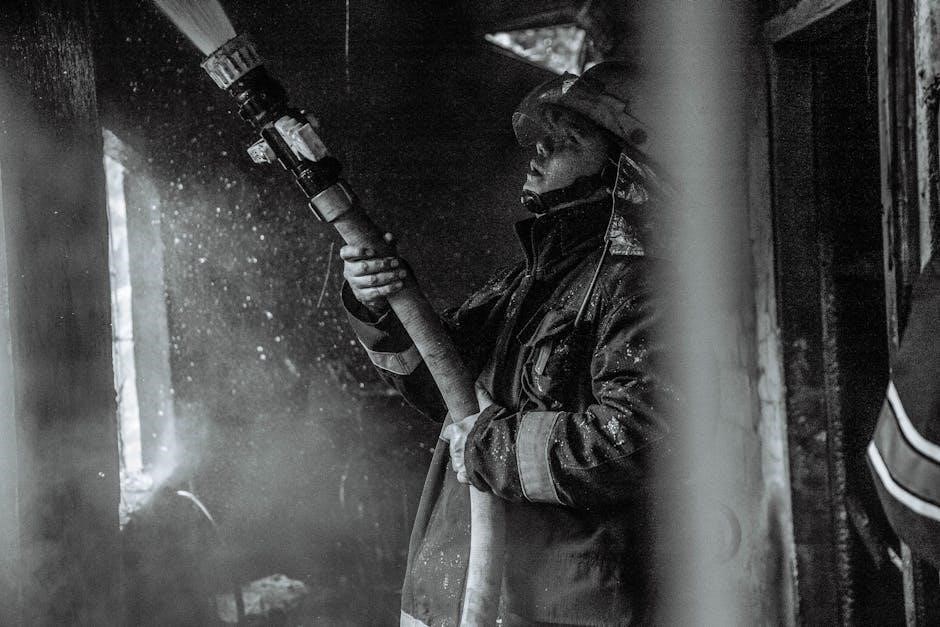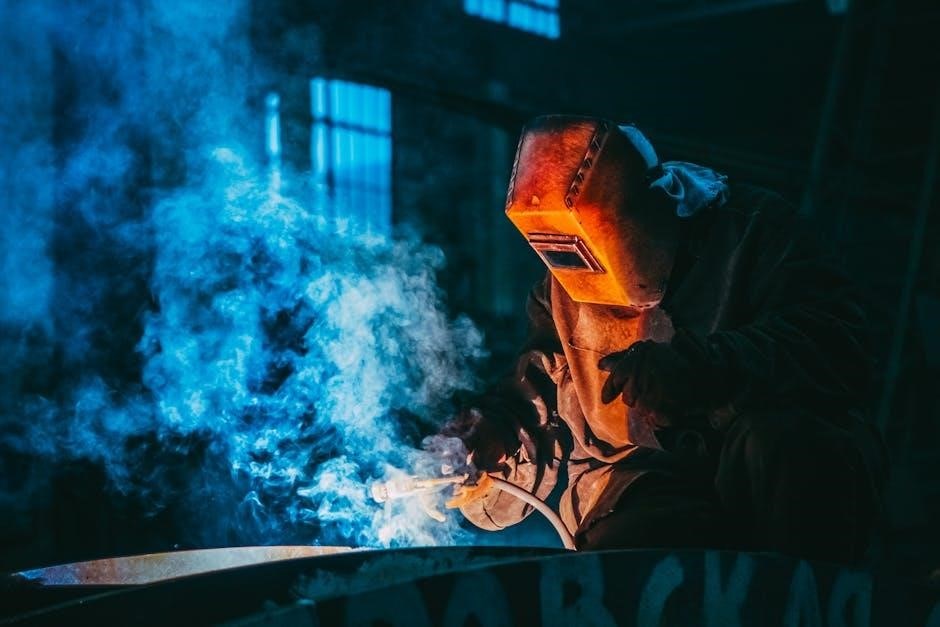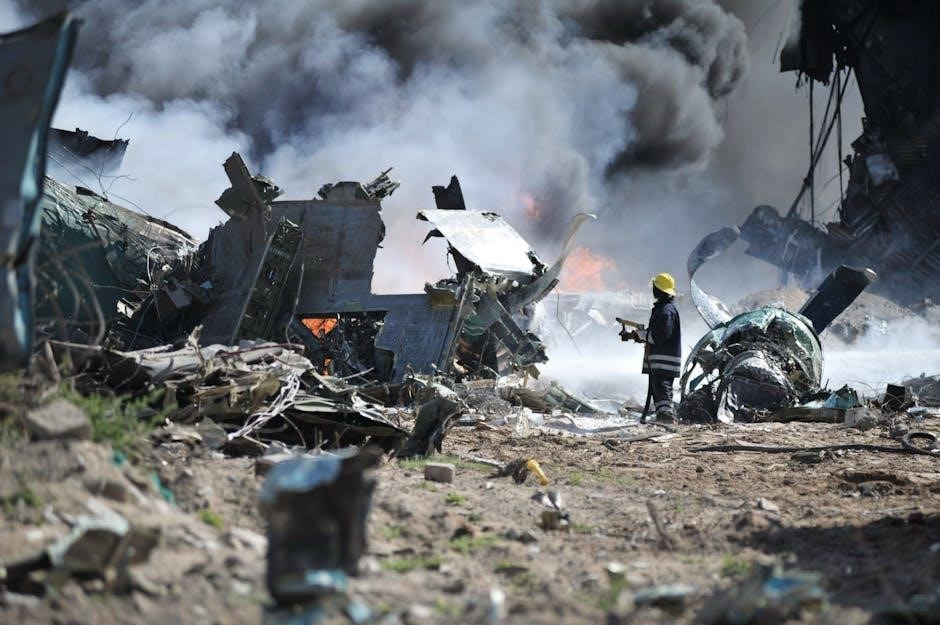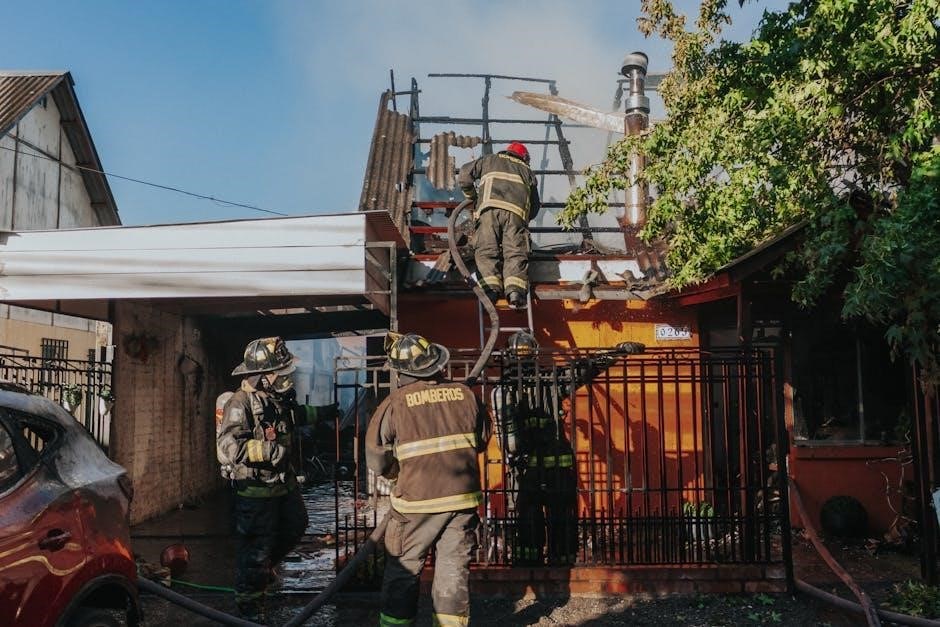NFPA 2112: Standard on Flame-Resistant Garments
The NFPA 2112 standard, developed by the National Fire Protection Association, focuses on flame-resistant garments designed to protect industrial personnel from short-duration thermal exposures caused by fires. It specifies minimum performance requirements and test methods for fabrics and garments.
Overview of NFPA 2112
NFPA 2112, officially titled “Standard on Flame-Resistant Garments for Protection of Industrial Personnel Against Short-Duration Thermal Exposures from Fire,” addresses the critical need for protective clothing in environments where flash fire risks exist. This standard establishes the minimum performance criteria and testing requirements for flame-resistant (FR) fabrics and garments used in industrial settings. It aims to reduce burn injuries among workers exposed to potential flash fires. The standard outlines specific requirements for garment design, fabric performance, and certification processes to ensure that the garments provide adequate protection.
The standard encompasses various aspects of FR garment construction, including fabric composition, seam strength, and closure systems. By adhering to NFPA 2112, manufacturers can produce garments that meet stringent safety standards. This standard provides guidelines for creating safer work environments where the risk of flash fires is a concern. Regular updates to NFPA 2112 reflect advancements in FR technology and evolving industry best practices.
Purpose of the Standard
The primary purpose of NFPA 2112 is to provide a baseline level of protection for industrial personnel against the hazards of short-duration thermal exposures from fire, commonly known as flash fires. This standard aims to minimize burn injuries and improve the survivability of workers who may encounter such incidents in their work environments; By establishing minimum performance requirements for flame-resistant garments, NFPA 2112 ensures that these garments offer a defined level of protection.
The standard promotes the use of FR clothing that can resist ignition, prevent the spread of flames, and provide thermal insulation to the wearer. It also specifies testing methods to verify that the garments meet these performance criteria. NFPA 2112 serves as a crucial resource for manufacturers, employers, and employees in selecting and utilizing appropriate FR clothing. Ultimately, the standard contributes to creating safer workplaces by mitigating the risks associated with flash fire hazards.
Scope of NFPA 2112
The scope of NFPA 2112 encompasses the minimum design, performance, certification requirements, and test methods for flame-resistant garments intended for use in areas with potential short-duration thermal exposures from fire. It applies to garments used by industrial personnel in various industries where flash fire hazards exist. This includes industries such as oil and gas, chemical processing, and utilities.
The standard covers a range of garment types, including shirts, pants, coveralls, and jackets. It specifies the performance criteria for fabrics used in these garments, addressing factors such as flame resistance, heat transfer, and melting/dripping behavior. However, NFPA 2112 does not cover all aspects of personal protective equipment (PPE). It focuses specifically on flame-resistant garments and their ability to protect against flash fire hazards. The standard does not include respiratory protection, head protection, or other types of PPE.

Key Requirements of NFPA 2112
NFPA 2112 establishes key requirements for flame-resistant garments. These include fabric performance criteria, garment design requirements, and certification requirements. Garments must meet specific standards for flame resistance, heat transfer, and overall protective capabilities to ensure safety.
Fabric Performance Criteria
NFPA 2112 outlines stringent fabric performance criteria to ensure adequate protection against flash fire hazards. These criteria include specific tests and requirements that fabrics used in flame-resistant garments must meet to be certified under the standard. The fabric must self-extinguish quickly upon removal from a direct flame. Melting and dripping of the fabric are strictly prohibited, as this can exacerbate burn injuries.
Furthermore, the standard specifies a maximum char length, typically less than 4.0 inches, to limit the extent of damage to the fabric when exposed to flame. Additionally, the fabric must exhibit an after-flame of no more than 2.0 seconds, indicating rapid flame suppression. These performance criteria are crucial for minimizing burn injuries and ensuring the effectiveness of flame-resistant garments in hazardous environments. Fabrics must maintain their protective properties after multiple launderings, ensuring durability and long-term performance. These criteria are integral to worker safety.
Garment Design Requirements
NFPA 2112 not only focuses on fabric performance but also sets specific garment design requirements to maximize protection. Garments must be designed to provide full body coverage, minimizing exposed skin areas that could be vulnerable to burns. The garment must be fully closed and not covered by other clothing or equipment to comply with applicable standards.
Design features like closures, such as zippers and buttons, must be flame-resistant and designed to remain securely fastened during a flash fire event. Overlaps and closures should be strategically placed to prevent flame penetration. There shall be no folds on arms or pants legs and all traps and other adjustment features on garments must be closed and adjusted to fit. Adjustments must be secure to prevent gaps. These requirements ensure that the garment provides a continuous barrier against heat and flames, enhancing worker safety in hazardous environments where flash fires are a risk.
Certification Requirements
To ensure compliance with NFPA 2112, garments must undergo rigorous certification processes conducted by independent, third-party testing organizations. These organizations evaluate garments against the standard’s performance criteria, verifying that they meet the necessary requirements for flame resistance, heat transfer, and overall protective capabilities. Essential for manufacturers and certifying agencies, the NFPA 2112-2023 standard protects workers from flash fire exposure and injury by specifying the minimum performance requirements and test methods for flame resistant fabric and garments.
The certification process involves thorough testing of fabric samples and complete garment prototypes. If the garments pass all the required tests, the certifying agency issues a certification mark or label, which indicates that the garment meets the NFPA 2112 standard. This certification provides assurance to end-users that the garments have been independently verified and are suitable for use in environments where flash fire hazards exist. It is crucial for employers to only purchase and provide certified NFPA 2112 garments to their employees.

Relationship with NFPA 2113
NFPA 2113 serves as a crucial companion standard to NFPA 2112. It provides guidance on the selection, care, use, and maintenance of flame-resistant garments, ensuring their continued effectiveness in protecting against flash fire hazards.
Selection, Care, and Maintenance
Proper selection, care, and maintenance are crucial for ensuring the continued effectiveness of NFPA 2112-compliant flame-resistant (FR) garments. NFPA 2113 provides comprehensive guidance on these aspects, serving as a vital companion standard. Selection involves choosing the appropriate garment for the specific hazards present in the workplace, considering factors such as the type of potential fire exposure and the required level of protection.
Care and maintenance are equally important. FR garments must be properly laundered according to the manufacturer’s instructions to maintain their flame-resistant properties. Avoid using detergents or additives that can compromise the fabric’s protective qualities. Regular inspection for damage, such as tears or excessive wear, is essential, and damaged garments should be repaired or replaced promptly.
Proper storage is also necessary to prevent contamination or degradation of the FR fabric. Following these guidelines ensures the longevity and effectiveness of FR clothing, maximizing worker safety.
Best Practices for FR Clothing Programs
Implementing best practices for FR clothing programs is essential for maximizing worker safety and ensuring compliance with NFPA 2112. A comprehensive program should begin with a thorough hazard assessment to identify potential fire risks and determine the appropriate level of protection required. This assessment should guide the selection of FR garments that meet the specific needs of the workplace.
Employee training is a critical component of any successful FR clothing program. Workers must be educated on the proper use, care, and maintenance of their FR garments, as well as the limitations of the clothing. Regular inspections of FR garments should be conducted to identify any damage or wear that could compromise their protective capabilities.
Furthermore, a well-defined policy should outline the responsibilities of both employers and employees in maintaining the effectiveness of the FR clothing program. By following these best practices, organizations can create a safer work environment and minimize the risk of burn injuries.

Changes in the 2018 Edition
The 2018 edition of NFPA 2112 introduced key updates, including refined terminology like changing “flash fire” to “short duration thermal exposure.” It also aligned with NFPA 1971 by adding “inherent flame resistance.”
Updated Terminology
The 2018 edition of NFPA 2112 brought forth revisions in terminology to enhance clarity and consistency within the standard and across related NFPA documents. One significant change was the refinement of the term “flash fire,” which was updated to “short duration thermal exposure from fire.” This modification aimed to provide a more precise description of the hazard addressed by the standard, focusing on the limited time frame of exposure.
Another key addition was the inclusion of the term “inherent flame resistance.” This term aligns NFPA 2112 with NFPA 1971: Standard on Protective Ensembles for Structural Fire Fighting and Proximity Fire Fighting.
These updates ensure that the terminology used accurately reflects the nature of the hazards and the protective qualities of flame-resistant garments. The intent is to minimize ambiguity and promote a clearer understanding among users, manufacturers, and certifying agencies.
Alignment with NFPA 1971
The 2018 edition of NFPA 2112 reflects a deliberate effort to align with other relevant NFPA standards, particularly NFPA 1971: Standard on Protective Ensembles for Structural Fire Fighting and Proximity Fire Fighting. This alignment ensures consistency in terminology and performance requirements across different types of protective clothing.
By incorporating terms like “inherent flame resistance,” NFPA 2112 harmonizes its language with NFPA 1971, promoting a more unified approach to fire safety standards. This consistency helps to avoid confusion and facilitates a better understanding of the various protection levels offered by different types of flame-resistant garments.
Furthermore, the alignment process contributes to improved interoperability between standards, making it easier for users to select and use appropriate protective clothing for specific hazards. This coordinated approach enhances overall safety and reduces the risk of accidents or injuries.

Application and Compliance
Compliance with NFPA 2112 requires using certified garments correctly. Garments must be fully closed and properly fitted, without folds, ensuring maximum protection. Understanding the limitations of flame-resistant clothing is also essential for workplace safety.
Proper Garment Use
To ensure optimal protection, proper garment use is critical when adhering to NFPA 2112 standards. Flame-resistant (FR) clothing should be worn correctly in potentially hazardous environments. Garments must be fully closed, with all closures secured to provide complete coverage. Overlapping layers of FR clothing offer enhanced protection compared to single layers.
Avoid wearing non-FR clothing over FR garments, as this can negate the protective qualities. Regular inspections are necessary to identify any damage, such as tears or excessive wear, which could compromise the garment’s integrity. Damaged garments should be promptly repaired or replaced. Proper fit is also essential; garments that are too loose or too tight may not provide adequate protection in a flash fire situation.
Ensure that sleeves are down and secured, and pant legs are not rolled up. Additionally, consider the specific hazards of the work environment when selecting and using FR clothing. Education and training on the correct usage and limitations of FR garments are essential for all personnel.
Limitations of Flame-Resistant Clothing
While NFPA 2112 compliant flame-resistant (FR) clothing offers significant protection against flash fires, it’s crucial to acknowledge its limitations. FR garments are designed to provide a degree of protection against short-duration thermal exposures, but they are not fireproof and cannot withstand prolonged exposure to intense heat or flames.
The level of protection offered by FR clothing can be reduced if it is damaged, improperly worn, or contaminated with flammable substances. It’s important to understand that FR clothing does not eliminate the risk of burns entirely. In situations involving extreme heat or extended fire exposure, additional protective measures may be required. Also, FR clothing provides no protection from electric arc or explosions, requiring additional PPE.
Therefore, comprehensive safety protocols, including hazard assessments and proper training, are essential to minimize risks in hazardous work environments. Workers must understand the specific hazards they face and the capabilities and limitations of their FR clothing.
